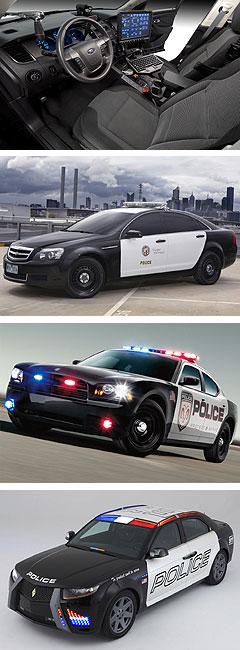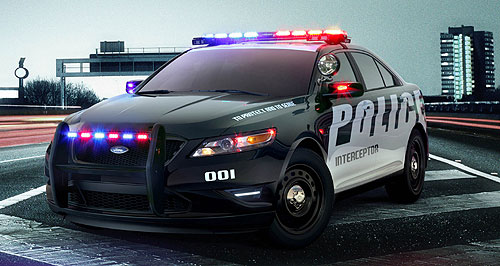Future models - Ford - Police InterceptorOfficial: Ford Taurus to intercept Holden’s US patrol carBlue light battle: First Taurus-based Ford Police Interceptor will compete directly with Australian-made Chevrolet patrol car. Ford's all-new Taurus-based Police Interceptor to pursue Holden's Chevrolet cop car14 Mar 2010 By MARTON PETTENDY and TERRY MARTIN FORD Motor Company has revealed its successor for North America’s most widely deployed law enforcement vehicle for the past 15 years, and the most serious threat to GM Holden’s greatest export hope. As expected, for the first time, Ford’s next purpose-built Police Interceptor will be based on the six-cylinder, front and all-wheel drive Taurus sedan, the model with which Australia’s Falcon could eventually share its chassis (and advanced V6 engines) under the ‘One Ford’ global platform-sharing strategy. The all-new Ford Police Interceptor is Ford’s direct response to the Holden Statesman-based Chevrolet Caprice Police Patrol Vehicle (PPV), which will enter production in Adelaide late this year before hitting the beat in America in early 2011. Ford’s first Taurus-based police car is due to enter production in Chicago a year later in late 2011 as a seamless replacement for Ford’s now iconic Crown Victoria, whose V8-only, body-on-frame design dates back to 1992. It will be joined by an additional pursuit-rated “utility” vehicle that is likely to based on Ford’s next-generation Explorer SUV rather than a small ute, which forms the basis of police divvy vans in Australia, but Ford is withholding specific details until the third quarter of this year. Ford said the utility would be built off the same platform, and would meet the same safety and performance standards, as the sedan, and has previously confirmed the next-generation Explorer will be underpinned by an integrated monocoque platform. “This model is also purpose-built and police-rated for regular patrol applications,” Ford states. The Falcon, the only large rear-drive sedan left in the Ford world besides the Crown Victoria and Ford’s closely related Lincoln Town Car and Mercury Grand Marquis, was always a long-shot to form the basis of a replacement for the Crown Victoria. A fleet-only proposition in the US since the 2008 model year, the Crown Victoria last year attracted about 75 per cent of the lucrative US law enforcement vehicle business, which also includes pursuit versions of the Dodge Charger and front-drive Chevrolet Impala, with between 40,000 and 50,000 police car sales. Start-up Indiana-based company Carbon Motors has also committed to producing a dedicated police patrol car for North America, codenamed E7 and powered by a turbo-diesel engine, from 2012. But GM expects its imported Chevrolet PPV, which like the Charger will be available in V6 and V8 police guise, to gain a large slice of an annual North American fleet market that it estimates could total as many as 80,000 vehicles. Senior GM executives, including the man behind the Chevrolet PPV, GM North America president and ex-GM Holden chief Mark Reuss, have suggested a potentially even more profitable civilian vehicle export program could follow. The appearance on a Pontiac G8 web forum in November of an official GM email that refers to the “MY11.5 Chevy Police Program and MY12 Chevy SS” has fuelled expectations GM will resurrect a high-performance version of the Commodore-based Pontiac G8, which was discontinued when GM axed its historic Pontiac brand as part of its survival plan last year. Determined to maintain its market domination, Ford has distanced itself from General Motors’ Australian strategy for its North American squad car, emphasising the Interceptor’s status as “engineered and built in America”. FoMoCo group vice-president of global marketing made it clear to GoAuto at the Los Angeles motor show last December that the US auto giant would not follow GM’s lead in establishing an export program from Australia for its new-generation US police car. This is, however, the first official acknowledgment the engineering role was centred in the US. “Police nationwide asked for a new kind of weapon in the battle for public safety, and Ford is answering the call with a purpose-built vehicle – engineered and built in America – that’s as dynamic as it is durable,” said Ford president of The Americas, Mark Fields. “Ford remains committed to leading the police vehicle market, and our new Police Interceptor demonstrates how much engineering and innovation we’re willing to invest to address the unique needs of those who protect and serve communities throughout America.”  From top: Taurus-based 2012 Ford Police Interceptor concept's interior, Holden's 2011 Chevrolet PPV, current Dodge Charger patrol car, 2012 Carbon E7 concept. As well as reinforcing its One Ford program, and confirming speculation that the police car would spring from Taurus, the Interceptor points the way to the potential drivetrains for future Taurus-based Falcon models. From top: Taurus-based 2012 Ford Police Interceptor concept's interior, Holden's 2011 Chevrolet PPV, current Dodge Charger patrol car, 2012 Carbon E7 concept. As well as reinforcing its One Ford program, and confirming speculation that the police car would spring from Taurus, the Interceptor points the way to the potential drivetrains for future Taurus-based Falcon models.There is no V8 in sight, as there is in the Chevrolet Caprice PPV, but two V6 petrol engines in “police powertrain calibration” that Ford claims will perform “equal to or better than V8 engines”. Nor will there be an appearance of the new 3.7-litre V6 that Ford this week proclaimed will make the 2011 Mustang V6 – which has attracted half of more than 11,000 orders before the new model goes on sale in the US within three months - the first car ever to deliver 300-plus horsepower (305hp, or 227kW) and 30-plus miles per gallon on the highway (31mpg or 7.6L/100km, with an optional six-speed automatic transmission). Instead, the baseline engine will be a 3.5-litre E85 ethanol-compatible version of the Duratec V6 that was to have replaced Ford Australia’s current 4.0-litre inline six this year, before the decision was made to upgrade the Falcon and Territory’s straight six to meet the Euro 4 emissions standard from July. The entry-level Taurus pursuit car engine is claimed to deliver “at least 263 horsepower” (196kW) and is said to be 25 per cent more efficient that the 4.6-litre SOHC V8 offered in the current Crown Victoria Police Interceptor. The second is an EcoBoost twin-turbocharged direct-injection 3.5-litre V6 that produces “at least” 365 horsepower (272kW) and 475Nm of torque “across a broad rpm range”. This version drives all four wheels via a ‘high-capacity’ six-speed SelectShift automatic transmission. Ford vehicle line director for cars and crossovers Scott Tobin said: “We have an extremely powerful standard engine, and to top that off, we also offer our exclusive EcoBoost technology. Both are designed for the severe-duty cycle that police engage in on a daily basis.” Mr Tobin said Ford engineers worked “hand in hand” with the company’s police advisory board, which provided key input on vehicle attributes, such as performance, safety, durability, driver comfort and functionality. “Their feedback mattered to us,” he said. “Safety and durability were at the top of their list, so safety and durability were at the top of ours.” Ford claims that EcoBoost brings municipalities and police fleet administrations the “first ultra-high-performance yet environmentally friendly police pursuit vehicle”. In demonstrating the Interceptor’s safety attributes, Ford claims that the vehicle was engineered to pass 75mph (120km/h) rear-end crash-testing and will be fitted with the Safety Canopy side curtain airbag rollover protection system. The latter protects both front and rear window-seat passengers in rollover and side-impact crashes, with multiple airbags firing as required using Ford’s so-called Roll Fold technology. Dual front airbags and seat-mounted front side-impact airbags will also be fitted standard, with factory installed ballistic door panels optional. Other technology onboard includes a rear-view camera, blind spot warning device, a ‘Cross Traffic Alert’ warning assists when reversing, and a hands-free information system that can be customised and remapped to work with police aftermarket equipment such as lights and sirens. In order to meet the rigorous durability requirements set by authorities such as the Michigan State Police and Los Angeles County Sherrif’s Department, Ford engineers have also developed a unique braking package, 18-inch steel wheels (with a 40mph/64km/h kerb-impact rating), an undercarriage deflector plate, a larger radiator and a heavy-duty alternator (minimum 220 amp), cooling system and front-subframe. The Interceptor also has police-tuned suspension with heavy-duty springs and shocks. The cabin, which Ford claims was redesigned “approximately 90 per cent”, is brimming with police-specific design features. The front seats, for example, have anti-stab plates inserted and have had the lower bolstering removed to better accommodate officers’ utility belts. A column shift was also engineered in order to keep the console area clear for aftermarket police equipment. The vinyl rear seats have been sculpted and set back further than a conventional sedan to improve back-seat space and maximise legroom. The rear door hinges are also modified to open up a further 10 degrees compared to traditional rear doors. “This vehicle is pursuit-ready,” said Ford vehicle engineering manager Carl Widmann. “It’s no-nonsense, through and through.” Production at Ford’s Chicago III assembly plant will proceed “without interruption” when manufacturing of the Crown Victoria Interceptor ends late next year. The Interceptor made its world debut yesterday in front of a select group of law-enforcement officials gathered at the Las Vegas Motor Speedway.  Read more18th of January 2010  Ford yet to decide Aussie engine futureTop executive to evaluate post-Euro 5 future of Ford Australia six-cylinder engine12th of January 2010  Falcon on the brinkFord chief signals end of go-it-alone Falcon as Taurus looms as replacement7th of December 2009  Holden cop car prowls LAChevrolet rolls out the Holden-based Chevrolet Police Patrol Vehicle at the LA Show4th of December 2009  Ford US cop car decision loomsFord’s new US police pursuit car will not be made Down Under5th of October 2009  Official: Holden to export Commodore as US police carLucrative new US export deal emerges as Holden reveals its Stateside police carAll future models Alfa Romeo Alfa Romeo Abarth Abarth Alpine Alpine Alpina Alpina Audi Audi Aston Martin Aston Martin BMW BMW Bentley Bentley Chery Chery Brabham Brabham Chrysler Chrysler Chevrolet Chevrolet Cupra Cupra Citroen Citroen DS DS Dodge Dodge Fiat Fiat Ferrari Ferrari Foton Foton Ford Ford Great Wall Great Wall FPV FPV Haval Haval GWM GWM Honda Honda Holden Holden Hummer Hummer HSV HSV Infiniti Infiniti Hyundai Hyundai Jaguar Jaguar Isuzu Isuzu Kia Kia Jeep Jeep Land Rover Land Rover Lamborghini Lamborghini Lexus Lexus LDV LDV Mahindra Mahindra Lotus Lotus Mazda Mazda Maserati Maserati Mercedes-AMG Mercedes-AMG McLaren McLaren MG MG Mercedes-Benz Mercedes-Benz Mitsubishi Mitsubishi Mini Mini Opel Opel Nissan Nissan Peugeot Peugeot Pagani Pagani Proton Proton Porsche Porsche Renault Renault Ram Ram Rover Rover Rolls-Royce Rolls-Royce Skoda Skoda Saab Saab SsangYong SsangYong Smart Smart Suzuki Suzuki Subaru Subaru Toyota Toyota Tesla Tesla Volvo VolvoMotor industry news |
Click to shareFord modelsResearch Ford All future models Alfa Romeo Alfa Romeo Abarth Abarth Alpine Alpine Alpina Alpina Audi Audi Aston Martin Aston Martin BMW BMW Bentley Bentley Chery Chery Brabham Brabham Chrysler Chrysler Chevrolet Chevrolet Cupra Cupra Citroen Citroen DS DS Dodge Dodge Fiat Fiat Ferrari Ferrari Foton Foton Ford Ford Great Wall Great Wall FPV FPV Haval Haval GWM GWM Honda Honda Holden Holden Hummer Hummer HSV HSV Infiniti Infiniti Hyundai Hyundai Jaguar Jaguar Isuzu Isuzu Kia Kia Jeep Jeep Land Rover Land Rover Lamborghini Lamborghini Lexus Lexus LDV LDV Mahindra Mahindra Lotus Lotus Mazda Mazda Maserati Maserati Mercedes-AMG Mercedes-AMG McLaren McLaren MG MG Mercedes-Benz Mercedes-Benz Mitsubishi Mitsubishi Mini Mini Opel Opel Nissan Nissan Peugeot Peugeot Pagani Pagani Proton Proton Porsche Porsche Renault Renault Ram Ram Rover Rover Rolls-Royce Rolls-Royce Skoda Skoda Saab Saab SsangYong SsangYong Smart Smart Suzuki Suzuki Subaru Subaru Toyota Toyota Tesla Tesla Volvo VolvoMotor industry news |
















Facebook Twitter Instagram